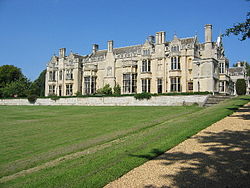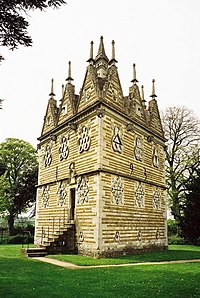Rushton, Northamptonshire
- Not to be confused with Rushden
| Rushton | |
| Northamptonshire | |
|---|---|
 Rushton Hall | |
| Location | |
| Grid reference: | SP841829 |
| Location: | 52°26’16"N, -0°45’49"W |
| Data | |
| Population: | 461 (2011) |
| Post town: | Kettering |
| Postcode: | NN14 |
| Dialling code: | 01536 |
| Local Government | |
| Council: | North Northamptonshire |
| Parliamentary constituency: |
Kettering |
Rushton is a village in Northamptonshire. It is about two miles north-east of Rothwell and three miles north-west of Kettering. The parish extends over both sides of the River Ise and contains the sites of three deserted settlements.
The village's name means 'farm/settlement which is rushy'.[1]
At the time of the 2011 census, the parish's population was recorded as 461.
The village has a primary school, a pub opposite the village cricket pitch, a health retreat, bed and breakfast and hotel.
There is a bus service that runs through the village linking Rushton to neighbouring towns. It goes hourly and the bus stop is opposite the pub, the Thornhill arms.
Buildings

By the village stands the Rushton Triangular Lodge which is in the former grounds of Rushton Hall, which is half a mile west of the village; the hall is currently a hotel.
All Saints' Church is of Norman origin but mostly 14th-century with 19th-century restorations in 1853 and 1869 by Edmund Francis Law. There is a monument to Sir Thomas Tresham (died 8 March 1559) of Rushton Hall.[2]
Other notable buildings in the village include a Manor House east of the church, Manor Farm House (17th-century) and the Georgian Old Rectory.[2]
Deserted settlements
The location, history and remaining physical evidence of three deserted settlements within the parish have been systematically documented.[3]
Barford - This stood near Barford Lodge and is listed in the Domesday Book with seven recorded inhabitants. In 1516, George Boyvil enclosed 86 acres of arable land at Barford and it was reported that "almost the whole village" was destroyed. The chapel that formerly served this village was no longer in existence in the early 18th century.
Glendon - This was immediately east of Glendon Hall, with a recorded population of fourteen in the Domesday Book. In 1327, there were ten tenants on the manor.[4] In 1514, Robert Malory enclosed 494 acres of arable land as well as pasture. At that time, nine out of the twelve houses were destroyed.
Rushton St Peter - The site of this settlement is in the area of Rushton Hall. It was listed along with Rushton All Saints in the Domesday Book with a combined recorded population of 45. In the 1524 Subsidy Returns, only ten people paid tax at St Peter's parish, compared to 28 in All Saints.[5] In the early 18th century, it was recorded that the only buildings in St Peter's parish were the hall, the church and four or five shepherd's lodges.[6] The two Rushton parishes were united in 1780 and a faculty was granted in 1799 for the demolition of St Peter's church.
Outside links
| ("Wikimedia Commons" has material about Rushton, Northamptonshire) |
References
- ↑ "Key to English Place-names". http://kepn.nottingham.ac.uk/map/place/Northamptonshire/Rushton.
- ↑ 2.0 2.1 Nikolaus Pevsner: The Buildings of England: Northamptonshire, 1961; 1973 Penguin Books ISBN 978-0-300-09632-3page 397 et seq
- ↑ Archaeological sites in Central Northamptonshire: An Inventory of the Historical Monuments in Northamptonshire, Volume 2,
- ↑ The National Archives: SC12/13/29.
- ↑ The National Archives: E179/155/133.
- ↑ John Bridges (1791). The History and Antiquities of Northamptonshire. Compiled from the manuscript collections of the late learned antiquary, John Bridges, Esq. By the Rev. Peter Whalley, late fellow of St. John's College, Oxford. Oxford. pp. 67–8.
